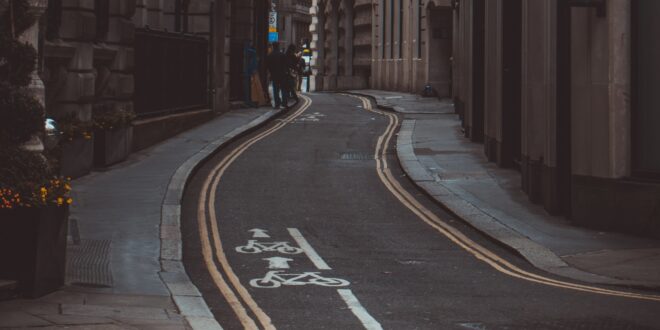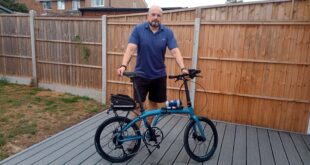Better infrastructure could be the key to retaining new cyclists following the Covid boom. Rebecca Bland explores how safer roads could bring more customers to the cycling and e-scooter market
This piece first appeared in the August edition of BikeBiz magazine – get your free subscription here
Infrastructure that encourages micromobility is a hot topic. Often not far from the newspaper columns, with the same points being printed: ‘bike lanes cause congestion’, ‘they’re always empty, nobody uses them!’
But as fuel prices continue to rise and transport costs have reached new heights, is infrastructure the key to enticing new consumers to the cycling, e-bike and e-scooter markets?

It is widely reported that the biggest barrier to entry for many people who want to travel on two wheels is safety, as head of campaigns and advocacy for Cycling UK, Duncan Dollimore told MMB’s sister title BikeBiz.
“Typically, two-thirds of people who don’t cycle say it’s safety on the roads that put them off.
“The health benefits of cycling massively outweigh any risks, but that’s not how it feels to many people, and it’s that which puts them off cycling, and it disproportionately puts more women off cycling than it does men.”
Even experienced riders know the feeling of risk and heightened awareness when riding in a busy environment, but the infrastructure can help to alleviate some of this fear – particularly when talking about protected bike lanes.
However, as positive as segregated lanes are for riders, they’re not always the most popular policy, and regions outside of London are lagging behind when it comes to building more.
“London is the classic example that shows when you do start to build that infrastructure, that people will use it and that will increase the number of people who cycle. We saw that when the cycle superhighway was constructed along the [Thames] embankment,” Dollimore continued.
“And we now have this curious situation where some media commentators love to tell us that cycle lanes cause congestion. However, we have this scenario where 75% of the traffic across Blackfriars Bridge during the two rush hours occupies 20% of the road space, which is the cycle lane.”
There are many other instances of this ‘build it and they will come’ phenomenon occurring, particularly across London, and it’s something that retailers have noticed, as Henry Hayes, head of marketing and communications at electric bike retailer Fully Charged explained.
“Whenever we see areas of London become pedestrianised, we will see an influx of people from that area coming to us to buy bikes. For instance in Dulwich, there’s a one-way system now, which is making it increasingly hard for parents to drop their kids off at school in a car.
“What used to be a 15-minute car journey there and back to get through central Dulwich, now is 45 minutes to an hour, based on what a lot of people are telling us. Using a bike drops that back down to say 20 minutes and we find ourselves dealing with those types of parents a lot.
“Similarly, in places like Islington, there’s a one-way system now, and we find a lot of people coming to us who find that needing or wanting a car in that area is completely futile and so they’ll just use a bike to get around and get the kids around on a bike.”
This depth and breadth of consumers, from commuters to families, is exactly why encouraging safe measures is key to getting more people on two wheels. It’s difficult to say exactly what the e-scooter legislation will be, and where they will be able to be used, but in terms of driving the use of low-cost sustainable transport, keeping users separated from motor traffic will be key, as Dollimore was keen to emphasise.
“I think it would be fair to say there’s certainly a capacity for separated infrastructure to be used for people riding e-scooters that could increase the numbers using them. But, there are a lot of known unknowns in terms of what direction the legislation is going to go in and how it’s going to end up looking. So it’s a bit early to say what exact impact the infrastructure will have on e-scooter use.”
The term infrastructure is quite broad, encompassing everything from segregated cycle lanes to off-road routes and even things that may not be more obvious, like lower speed limits. With much of the country behind London and other large cities in terms of infrastructure, it’s important to look beyond the simple delegation of ‘just stick a cycle lane in’ in other parts of the country, particularly more rural communities.

Retailer Fully Charged has stores across the south, and Hayes explained how Cornwall is tackling the issue of rural infrastructure.
“Cornwall is pushing heavily for decarbonisation across multiple industries, and various towns are becoming no-car zones.
“With the number of hills there are, there’s no doubt you need a car to get around but what they’re saying is, ‘If it’s a short distance, then bike is best.’”
Elsewhere, Cycling UK has seen positive results from the Scottish government’s Spaces for People programme, in which local authorities bid for active travel funding.
“Many of the cities introduced cycle lanes, but then lots of the towns took the money and instead decided that they were going to introduce town-wide 20mph zones around and into those market towns,” continued Dollimore.
“And the results from those trials were really positive, and a huge number of those towns are continuing to introduce a permanent 20mph zone into and around the town centres.
So there are things that can be done which are infrastructure-related and don’t involve separated cycle lanes. And some of those things are options and alternatives in more rural areas and outside the busy cities.
“There is a space for some clever thought about what we might do, but we shouldn’t just be adopting an approach of saying ‘it’s only the cities that should benefit from infrastructure to get more people cycling’.”
There is no one size fits all approach to building infrastructure for cyclists and e-scooters. However, if governments want to increase the use of these forms of transport, they must recognise the difference creating a safer environment can make.
Safety is the number one barrier to entry, so addressing speed limits, or creating segregated cycle lanes, for instance, will surely yield the best results and encourage more people to ride and scoot their way around.
 micromobilitybiz Delivering news updates to the micromobility industry, focusing on e-bikes, e-scooters and green transport
micromobilitybiz Delivering news updates to the micromobility industry, focusing on e-bikes, e-scooters and green transport




